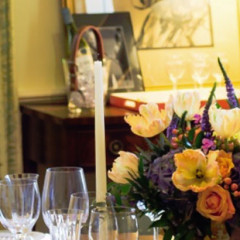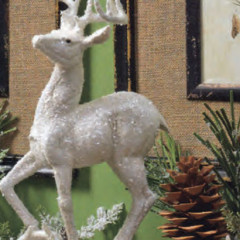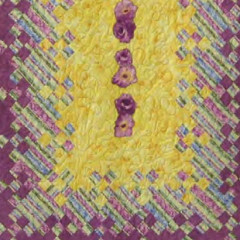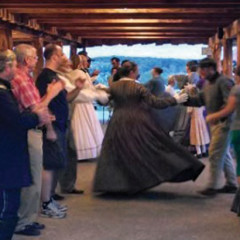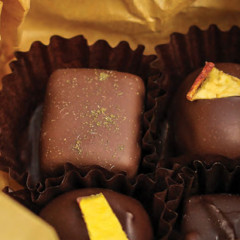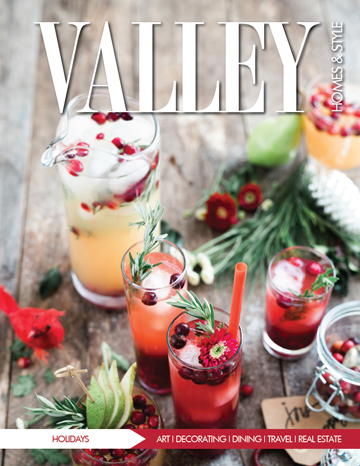REPURPOSING
Green Chic to Enhance Any Décor by Fred Wish and Loretta Bolger Wish If you didn’t have a cable-spool table or cinder-block bookcase in your first apartment, your best friend probably did. Long before terms like repurpose, green and upcycle became part of our vocabulary, young people usually started out with a blend of castoffs and improvised housewares. Today, rescuing and revitalizing unused objects has become an art form that produces distinctive and often exquisite furnishings. From grand pianos renovated into bookcases, to 78 rpm records and bicycle gears made into clocks, to tabletops turned into message boards, these reclamation projects can add fun and function to any living space. “I’ve always seen beauty in the ability to reuse things,” says Deborah Terry, owner of the vintage shop Flamingo Girl Studio in Charles Town. “I hate to see something end up in the trash when it can be something else.” Among the works she’s proudest of are the Eastlake-style settee she cut up and made into Victorian coat racks and the ornate mirror she detached from a damaged bureau and fashioned into a chalkboard. Terry notes that a skillful paint job can glamorize the worst looking rejects such as old chairs and picture frames. This elegant segment of the repurposing trend is also represented by Denise Nolan and Bobbi Morris of Repurposed and Refined, located in Hagerstown and Frederick. Although their warehouse and shop contain informal products such as coasters made from Mason jar lids and a repainted bicycle wheel serving as a holder for photos, Nolan and Morris prefer converting fine but distressed furniture into pieces well suited to a formal parlor or grand entryway. Repurposed and Refined has a special regard for Spanish Revival pieces, with their elaborate turnings and bold combinations of wood and metal. Many of these have seen a century or so of hard wear but can be re-imagined with some effort and thoughtful planning. To encourage this creativity in do-it-yourselfers, Morris holds classes in painting techniques. Although they occasionally encounter critical remarks from purists regarding their use of paint and colored waxes on unadorned wood, Morris says they would rather see “an item that might be discarded left for future generations to use and enjoy.” With the right paint, stain or polish, even the rough surfaces of pallets, cable spools and wine barrels can become the finest of furniture. Or they can be sanded and stained lightly to preserve their rustic condition and fit into an outdoor décor or country-themed interior. For kitsch enthusiasts, repurposing offers a universe of fresh and funky design possibilities. Tables are being created from balcony railings, school blackboards,...
Through the Front Door
Home after the Holidays How to De-clutter and Freshen Up by Lisa Bartell of Wisteria Cove photos by Raz Imports Tree down Ornaments put away Santas and nutcrackers tucked away safely in their boxes Tinsel and glitter put away until next year House lifeless and dull Whoa! Back up! House lifeless and dull? I think we all have this same dilemma after the holidays. We go from “Ta-da!” with all that sparkle and shine from Christmas decorations to “Ho Hum!” boring when it all is put away. Some of us may have a stock pile of after-Christmas winter décor to revamp the house and bring it back to life. But if you’re like me and don’t have much storage, than an after Christmas treasure chest of winter goodies is out of the question. Here are a few ideas for both. Shop the house Without spending any money or taking up more storage space, shop your house. Look around and take things from one room and add them to another. For example, things don’t often really get appreciated in a seldom-used room like a guestroom, so bring these items out and show them off for a nice change. Switch accessories and home accents around out for a breath of fresh air such as a lamp, pillow, throw or piece of art work. You can even pull in a piece of furniture from another room such as a chest, side table or accent chair. Rearrange the existing furniture seating for a totally new look or switch out a rug. Don’t forget to add to the atmosphere by covering all the senses. Touch: include soft, winter fabrics. Smell: infuse the air with warm winter scents of pine and berries from a candle or potpourri. Sound: play your favorite music softly in the background. Sight: pull out some family photos of past winters, such as a photo of building a snowman, beautiful winter snowscapes of your home or winter wildlife. Also, don’t forget to let as much natural light in as possible to keep the doldrums away. Place a mirror across from a window to reflect more light into the space. Sunlight is full of vitamin D and is essential to our bodies in many different ways. Since you’re letting all that sunshine in, why not plant some winter indoor bulbs such as lovely paperwhites and vibrant Amaryllis? Cozy winter lodge Winter lodge is a warm and cozy theme full of woodland creatures and fresh winter plaids. Think of a cozy fire, sipping hot cocoa with family and friends. You can change out some of your framed prints for different ones depicting deer,...
Piecing Together Past and Present
by Tricia Lynn Strader After the hype of the holidays, during the long chilly days of winter, many of us might take a restful pause much like the hibernating bears. But the long days of winter are not a restful time for the members of the Delectable Mountains Quilters guild in Berkeley Springs. They work hard at creating quilts for those in need, and offer an array of contemporary and traditional quilts for their annual spring gallery show and auction. In May, much of the town of Berkeley Springs, W.Va., becomes a kaleidoscope of patterns and colors during the Yard Square Quilt Auction. At least 40 guild members make the wall hangings that adorn the shop windows over six weeks. The public can bid on their favorite, and they will find out on Memorial Day weekend who wins what. This year’s theme, “Home is Where the Heart Is,” challenges members to takes that theme and either make a traditionally patterned piece, or changes it up to create an unusual piece of art. Quilts have become a recognized art form over the last 30 years or so, beginning with the country’s Bicentennial in 1976; but they’ve been a staple of many households for hundreds of years. The layered covering not only keeps off winter’s chill, but in many cases tells the story of a family—its members and their journeys through life with its patterns like the log cabin, or the fabric which may be from a baby’s blanket or loved one’s clothing. Usually the wives and mothers made quilts of leftover scraps after making clothes, because early Americans and pioneers had to make due with every bit of fabric they had. Patterns developed that are unique to the U.S. At the gallery show, visitors or buyers will find any size they can imagine in any pattern or color of the rainbow. They might be two-dimensional as one would expect; or they might have three-dimensional objects on them like appliqués, buttons, or other found objects. A quilt might be hand-stitched or machine quilted. There’s a true variety. Some are strictly on display; others are for sale. These quilters love sewing, and try to make things for those in need. Every year, the guild picks a local charity to receive the proceeds from the Yard Square auction. This winter, the guild will decide on one recipient from seven organizations considered. The first recipient in 2006 was the Morgan Arts Council. Others have included the Humane Society, local library, and Starting Points Family Resource Center. They’ve made lap quilts for hospital patients or residents at nursing homes, and provide quilts that the sheriff’s...
Shenandoah Valley
Civil War Era Dancers by Cheryl M. Keyser Lesley Mack moves onto the dance floor in her soft-soled dance slippers. Her husband, Tom, escorts her in his dress leather shoes. As the music rises, they, along with other dancers, swing into place and begin a glorious evening of twirling, handing off, and stepping as part of the group known as the Shenandoah Valley Civil War Era Dancers. When one thinks of the Civil War, battles and bloodshed come to mind, certainly not dancing. Yet, despite the ongoing war, social occasions, such as dances, were still common on both sides of the Mason-Dixon line. And compared to today, they were very formal. The men dressed in their best frock coats; the women were decked out in dresses layered from the inside out. Women’s clothing was very elaborate, starting with drawers and a chemise, a corset and corset cover, a privacy petticoat, hoop, an over petticoat, and finally the dress. Print patterns with images of flowers and leaves predominated if one was better off, while simpler stripes or plaids served for those with fewer resources. The Macks dress accordingly when they do a presentation or hold a dance. “We use period patterns,” says Lesley, “but there are also places where you can get dresses, petticoats and uniforms off the rack. And it is important that the fabrics be made from natural fibers — linen, wool, or cotton — no synthetics.” The two of them had done some country-western dancing, but never anything from the Civil War era. Some influence came from both of their parents who enjoyed just about any style of dance, from waltz and fox trot to square dancing. Both were also schoolteachers, Lesley working with third graders, and Tom with the 4th grade. Each had 22 years of experience and over the course of that time, as they delved into local history, “a passion for learning about the Civil War” arose, explains Tom. They took their mutual interest to the next logical step — becoming reenactors with the Third Maryland, Company B, based in Hagerstown. Attending one of the reenactments in 2011, they met Robert Reedy, director of the Shenandoah Valley Minstrels where they found that no one had been hired to call out the dance formations. Tom volunteered and wound up “calling” five dances. So impressed was Reedy that he asked them to become regulars with his band. Of course, Tom naturally replied, “Sure we can learn to do that.” And learn they did. Their research involved a crash course in learning the necessary steps using tapes from the Library of Congress, burying themselves in reproduction 1860s...
Cao Lynchburg Chocolatiers
by Maggie Wolff Peterson It all started with a chick flick. Hungry for a hobby in which she might involve her husband, Mary Matice was inspired while watching the movie, “Chocolat.” Lushly romantic, the film features a tiny chocolate shop as the place where love takes hold. Matice got an idea. Small-batch chocolate, made impeccably, was something the she and her husband, Carl, could do together. That was four years ago. In November 2013, the couple opened Cao, a chocolate shop in Lynchburg that features their bars, bark, tasting squares and truffles. Once a teeming industrial port city and bastion of the Confederacy, today Lynchburg is home to Liberty University and an architecturally diverse, recovering downtown. Prior decades were unkind to downtown Lynchburg’s lofty, century-old brick warehouses, factories and mercantile stores, many of which remain underutilized. But recovery can be seen in a year-round farmer’s market, stylish new shops and restaurants that span from Halal Mediterranean to American comfort food. A former delicatessen, the 3,000-square-foot space now occupied by Cao retains the pressed-tin ceiling, globe pendant lighting, white subway tiles and original blackand- white linoleum floors of its predecessor. An enormous kitchen with two commercial ovens provides more than enough space to roast cacao beans. A fresh coat of deeply maroon paint — Mary Matice calls it “aubergine” — to match the wrappers on Cao chocolate bars, was almost all that was needed to renew the space. Mary Matice imagines converting a loft area at the back of the store for chocolate-making classes and educational displays. The main floor will be developed as a dessert lounge, where customers may enjoy pastries and fondue made with Cao chocolate, or attend tasting events that pair fine coffees or wine with chocolates. Counter service will provide customers with bars and boxed chocolates made onsite. Cao’s boutique chocolate will be different from most. It is not typical for a small retail chocolatier to begin with beans. Many boutique chocolatiers, even the most highend, begin with chocolate that has been made elsewhere and delivered in bulk. The candy makers then melt and reconfigure the bulk product for their specialty products. Not Cao. The Matices begin with the raw commodity. “I had never considered that you could do small-batch chocolate from the bean,” Mary Matice says. The purity of the process appealed to her. Each with diabetic tendencies, neither Mary nor Carl Matice was a big consumer of processed sweets. But taking cacao straight from the pod, roasting and hulling it, and then converting it to nibs and finally dark chocolate, allows them to control the recipe, the ingredients and the finished product. Their research...

